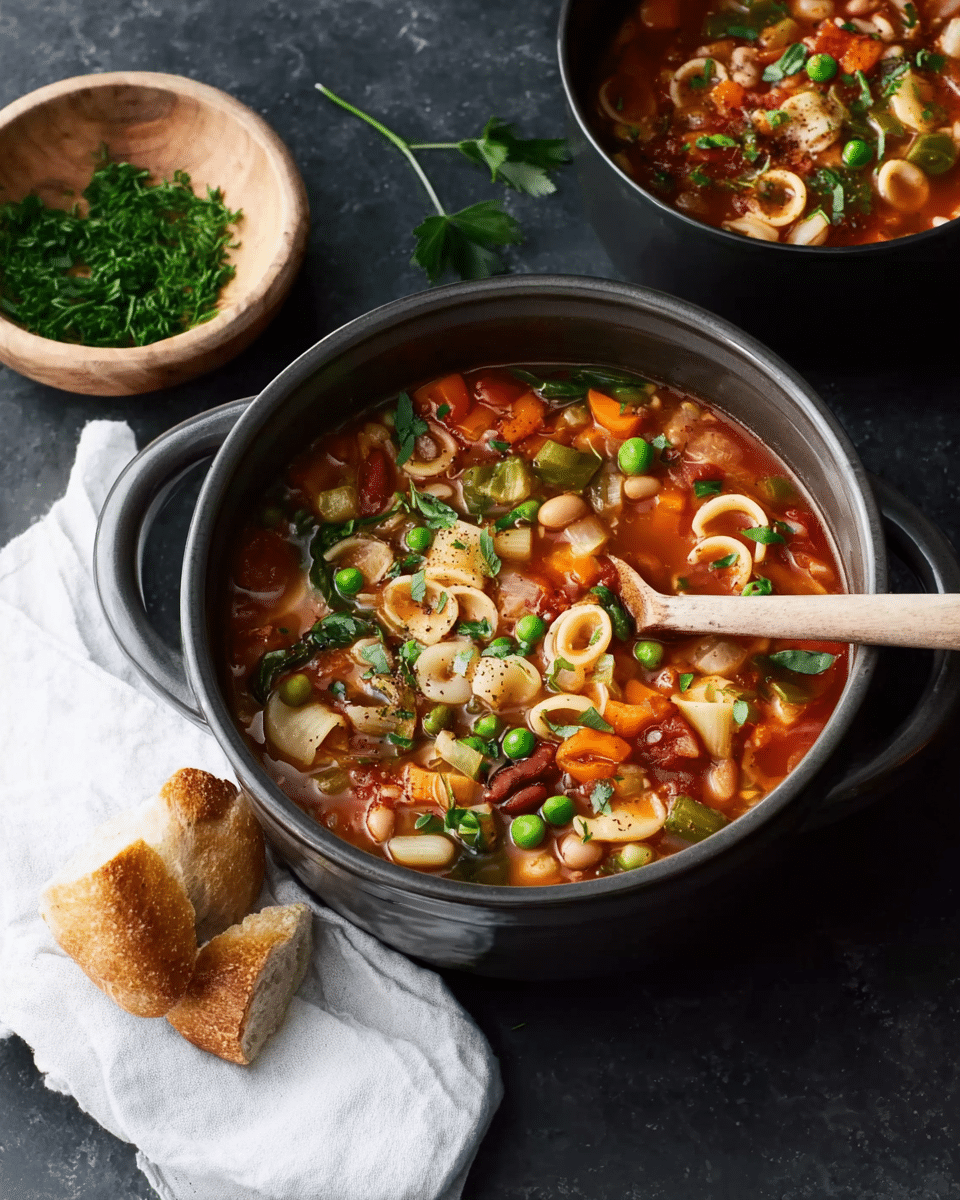The Classic Minestrone Soup is a vibrant, hearty, and nourishing dish that brings a bit of Italy to your table. Loaded with a medley of fresh vegetables, creamy beans, tender pasta, and aromatic herbs, this soup is a go-to for chilly evenings or when you’re craving something comforting yet light. Its rich tomato-based broth is deeply flavorful, thanks to a slow simmer with bay leaves, thyme, and oregano. Best of all, it’s easily adaptable—add whatever vegetables are in season or on hand. Whether you’re vegan, vegetarian, or just looking for a meatless meal, this minestrone delivers big taste with simple, wholesome ingredients.
Full recipe:
Ingredients:
-
2 tablespoons extra-virgin olive oil
-
1 medium yellow onion, diced
-
2 medium carrots, chopped
-
2 celery ribs, thinly sliced
-
1 teaspoon sea salt
-
Freshly ground black pepper, to taste
-
3 garlic cloves, grated
-
1 (28-ounce) can diced tomatoes
-
1½ cups cooked white beans or kidney beans, drained and rinsed
-
1 cup chopped green beans
-
4 cups vegetable broth
-
2 bay leaves
-
1 teaspoon dried oregano
-
1 teaspoon dried thyme
-
¾ cup small pasta (elbows, shells, or orecchiette)
-
½ cup chopped fresh parsley
-
Red pepper flakes (optional)
-
Grated Parmesan cheese (optional)
Directions:
-
Heat olive oil in a large pot over medium heat. Add onion, carrots, celery, salt, and pepper. Sauté for 8 minutes, until vegetables begin to soften.
-
Stir in the garlic and cook for 30 seconds until fragrant.
-
Add diced tomatoes, beans, green beans, broth, bay leaves, oregano, and thyme. Cover and simmer for 20 minutes.
-
Stir in the pasta and simmer uncovered for 10 minutes, or until pasta is cooked through.
-
Season to taste with salt and pepper. Remove bay leaves.
-
Serve hot, topped with parsley, red pepper flakes, and grated Parmesan, if using.
Prep Time: 15 minutes | Cooking Time: 30 minutes | Total Time: 45 minutes
Kcal: ~120 kcal per serving | Servings: 4–6 servings
The Heartwarming Origins of Minestrone Soup
Minestrone soup is one of Italy’s most beloved culinary treasures. Rooted in centuries of tradition, the word minestrone comes from the Italian word minestra, meaning “soup,” and it originally referred to a thick vegetable soup made by common folk using whatever ingredients were in season or on hand. It was considered a “poor man’s dish,” not because it lacked substance, but because of its humble, adaptable nature—farmers and home cooks made the most of what they had, often stretching ingredients to feed large families.
Over the years, this once-simple soup evolved to become a national staple, and every region in Italy boasts its own variation of minestrone. From the Ligurian version enriched with pesto to Tuscan versions using cavolo nero (Tuscan kale), each bowl of minestrone reflects the climate, produce, and tastes of its region. What remains constant, however, is the dish’s comforting heartiness, its deeply satisfying texture, and its rich, savory flavors.
Why Minestrone Soup Is a Must-Have in Every Home Kitchen
One of the reasons this minestrone soup recipe stands out is its versatility and convenience. Whether you’re short on time, cooking for a large group, or simply trying to use up what’s in your fridge, this dish has you covered. It’s budget-friendly, meal-prep-friendly, and perfect for freezing in batches.
More than just practical, this soup delivers a complex flavor profile that develops beautifully as it simmers. The classic combination of onion, garlic, carrot, and celery (known as soffritto in Italian cuisine) builds a flavorful base, while the tomatoes, beans, herbs, and pasta create a satisfying finish. The result is a dish that feels indulgent without being heavy.
Loaded with Nutritional Benefits
Beyond being comforting and delicious, minestrone soup is packed with nutrients. It’s naturally rich in fiber, plant-based protein, vitamins, and minerals—making it ideal for anyone seeking a healthy, balanced meal.
-
Fiber and Protein: Thanks to the beans and vegetables, each bowl supports digestive health and keeps you full longer.
-
Low in Fat, Big on Flavor: With minimal oil and no heavy creams, it’s a heart-healthy option.
-
Vitamins Galore: Carrots, green beans, tomatoes, and parsley provide vitamins A, C, and K, as well as antioxidants.
-
Low-Calorie Comfort: With approximately 120 kcal per serving, it’s a light yet satisfying dish perfect for weight-conscious eaters.
You can easily boost its nutritional value even further by adding dark leafy greens like kale or spinach, or swapping the pasta for a whole-grain variety.
Why This Recipe Is the Best
There are countless minestrone soup recipes out there, but this version strikes the perfect balance between simplicity, flavor, and nutrition. Here’s why it stands out:
-
Perfectly Balanced Texture: The mix of firm vegetables and tender pasta ensures a pleasing mouthfeel in every bite.
-
Adaptable Ingredients: While it lists specific vegetables and beans, you can substitute or add based on your pantry and season.
-
Deep Flavors with Minimal Ingredients: Dried herbs, garlic, and tomatoes build a robust flavor profile without needing meat or long cooking times.
-
One-Pot Convenience: Fewer dishes, faster cleanup. This is the kind of meal that makes your kitchen smell amazing without making a mess.
-
Crowd-Pleaser: It’s kid-approved, partner-approved, and even picky eaters enjoy the mild, comforting nature of the soup.
Seasonal and Customizable—Every Time You Make It
One of the joys of minestrone is how it evolves with the seasons. In summer, fresh Roma tomatoes and zucchini are beautiful additions. In winter, you might add cabbage, leeks, or sweet potatoes. In spring, asparagus or peas can make a bright addition.
Here are some of the most popular swaps and additions you can try:
-
Swap celery for fennel for a slightly sweeter, anise flavor.
-
Add zucchini or yellow squash in place of green beans.
-
Replace pasta with pearl barley or farro for a nutty, earthy taste.
-
Add kale or spinach near the end for a vitamin-rich boost.
-
Use homemade broth for deeper flavor and lower sodium content.
The beauty is, you can’t really go wrong—Minestrone welcomes improvisation.
Perfect for Meal Prepping and Leftovers
Minestrone soup stores beautifully. If you’re prepping meals for the week or making food in batches, this soup will become a favorite in your rotation. To make it even better for leftovers:
-
Cook pasta separately and add it to individual portions to avoid soggy noodles.
-
Freeze in individual servings using airtight containers. Just leave some headroom to allow for expansion.
-
Reheat gently on the stove or in the microwave. Add a splash of broth or water to restore consistency.
Prepared this way, the soup remains vibrant and flavorful days after it’s made.
Make It Vegan or Gluten-Free with Ease
This minestrone soup is already vegetarian, but with two tiny tweaks, it becomes fully vegan and gluten-free:
-
Vegan Option: Skip the Parmesan or top with vegan cheese or a dollop of dairy-free pesto.
-
Gluten-Free Option: Use gluten-free pasta or swap pasta entirely for grains like quinoa or brown rice.
These small adjustments make this soup perfect for nearly any dietary preference, allergy, or lifestyle.
Serving Suggestions That Complete the Meal
While this soup is satisfying on its own, pairing it with something simple can elevate the experience:
-
Crusty bread or garlic toast: Dip into the tomato broth for pure comfort.
-
A fresh arugula or pear salad: For a light contrast to the soup’s heartiness.
-
A drizzle of good olive oil and a sprinkle of red pepper flakes or fresh herbs: These toppings add layers of flavor and color right before serving.
Want to impress guests? Serve the soup in a rustic ceramic bowl with a side of warm focaccia and a glass of red wine. It’s cozy, elegant, and easy.
A Family Favorite That Brings People Together
One of the most beautiful things about minestrone soup is its power to bring people together. Whether you’re serving it as a weeknight meal for your family or bringing it to a friend recovering from illness, it nourishes both body and spirit.
It’s also a fantastic recipe to get kids involved in the kitchen. Let them stir the pot, sprinkle herbs, or choose which veggies go in. Because the recipe is so flexible, it’s perfect for teaching cooking basics and kitchen confidence.
Tips for Making the Best Minestrone Soup Every Time
To ensure your soup turns out perfectly with every batch, here are a few expert tips:
-
Don’t rush the soffritto: Taking time to soften the onion, celery, and carrots builds a strong flavor base.
-
Simmer gently: Over-boiling can break down the vegetables too quickly.
-
Taste and season at the end: The flavors intensify as the soup cooks, so adjust seasoning after the final simmer.
-
Use high-quality tomatoes: Since the broth relies on them, canned San Marzano tomatoes or ripe fresh ones make a big difference.
Conclusion
Minestrone soup isn’t just a dish—it’s a comforting ritual, a connection to generations of home cooks who knew how to nourish with love and simplicity. This particular recipe balances tradition and flexibility, making it one of the best minestrone variations you can prepare. It’s hearty, healthy, delicious, and designed to evolve with you—whether you’re a first-time cook or a seasoned kitchen pro.
So next time you crave something warm, flavorful, and good for the soul, remember this minestrone. It’s more than just a meal—it’s an experience worth sharing.






